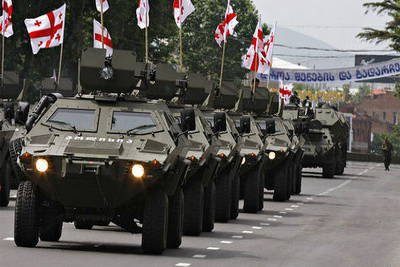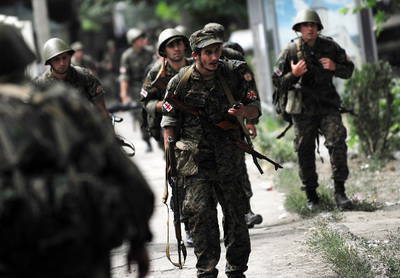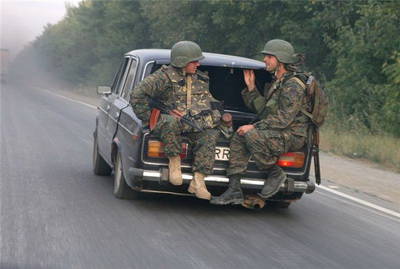The actions of the Georgian army in South Ossetia
The main goal is to “establish constitutional order” in South Ossetia, in order to return insurgent autonomy to Georgia, and then “restore constitutional order” in Abkhazia.
The military task is to crush the army of the "separatists", while at the same time neutralizing the peacekeeping forces of the Russian Federation, subsequently blocking the Roki Pass. Check out the concept of NATO and the United States on the conduct of hostilities in the mountains.
The political task is to expel the Ossetian population, which does not wish to be part of Georgia. Start talks on Georgia’s accession to NATO. Start the resettlement of Georgian refugees in South Ossetia.
The geopolitical objectives are to reduce the influence of the Russian Federation on the states of the South Caucasus. Provide aviation Israel and US airfields jump, in case of military operations against Iran. To accelerate the construction and laying of the next pipeline.
The technical task is to conduct a mass test of modernized weapons systems in real conditions. To test in practice the “fire organization centers” created with the help of Israeli military specialists.
Operation "Clean field"
This operation was developed by Georgia together with the staff of Military Professional Resources Incorporates (MPRI) and was directed against South Ossetia. It was the company MPRI, having signed a contract with Saakashvili, for many years engaged in the development of military operations and combat training of personnel of the Georgian troops. The consultants of this company were retired generals of the American army and a number of high-ranking "military retirees." These people still occupy the 4 floor of the Ministry of Defense of Georgia, where the entrance to the Georgian military is closed.

The Georgian army with a total number of about 20 thousand people was trained by American instructors, the cost of its creation amounted to $ 2 billion. The army tried, whenever possible, to abandon the old equipment of the Warsaw Pact countries and was preparing to conduct “local” wars, primarily with separatist enclaves within the borders of Georgia, as well as for use in peacekeeping operations outside its borders. Having the data of radar, air and space reconnaissance, the command of the armed forces of Georgia had extensive information about the structure and combat capabilities of the armed forces of South Ossetia and Russia. The tactics of the Georgian army was aimed at conducting a blitzkrieg. The basis for the preparation was taken from the lessons of the Middle East conflicts of Israel, the experience of the Iraqi and Afghan wars. The tactics of using infantry brigades implied the creation and operation of separate assault groups and the actions of special sniper and sabotage groups from among the military special forces of the Ministry of Internal Affairs Gia Gulua and Omega. The structure of the assault groups included two motorized rifle companies, a platoon tanks and the sappers department.
The plan for the military operation against the rebel enclave was based on the strategy of delivering two converging blows in the direction of Tskhinval. The main attack was carried out from the southern direction from the Gori area by the main group of troops, the main force of the 4 mbr. implied a deep semi-coverage of Tskhinval from the east, dissecting the defense of South Ossetia and access to the area of Tamarasheni settlement. Another blow was struck from the Karelian direction with the help of 3 mpbr and implied the semi-coverage of Tskhinval from the west and the internal coverage of Tskhinval from all sides along the outer boundary of the environment. The grouped Tskhinvali grouping was planned to be shackled by the MLRS and aviation. Artillery strikes should weaken the enemy as much as possible, disorganize him and force him to surrender the cities.
The first echelon of the advancing troops consisted of 3 and 4 Georgian motorized infantry brigades, the second echelon remained 1 mnbr, the advancing troops were provided by: a separate artillery brigade, a division of the RSZO, a separate tank battalion and an electronic warfare center of the Georgian Air Force. During the operation, it was planned to use sniper-sabotage groups of 10-12 people as efficiently as possible. The task of these “wandering Rangers” was to mine the roads in the rear of the enemy troops, disorganize and demoralize the defending troops, guide their aircraft and artillery to the detected targets, and when the Russian army advanced into the conflict zone, they had to switch to sabotage at its communications and communications centers .
The Georgian army made the main bet on achieving maximum fire in a short period of time. At the first stage, a large role was assigned to the massive use of rocket and artillery fire, corrected with the help of drones and air strikes. According to the plans, in 72 hours the Georgian army was to capture Tskhinvali, Dzhava and the Roki tunnel, in 3-4 days the troops were to capture about 75% of the territory of South Ossetia and shift efforts to the Abkhaz direction, where the actions of the ground forces would be supported by sea and airborne assault forces .
The Georgian side actively used military trick: deliberately withdrawing troops from the previously occupied quarters of Tskhinval, followed by shelling and bombardment while they were occupied by enemy troops.
Georgia focused its attention on night-time combat operations. It was at night that the Georgian army gained an advantage over the Russian troops. Georgian T-72 SIM-1 tanks, which have been modernized in Israel, have received thermal imagers, a friend-to-friend identification system, GPS and armor capacity.
Thanks to radio intelligence, radar and direction finding, Georgia tracked cell phone signals and struck fire on them. Georgian artillery gunners found excellent topographic maps and high-resolution images from outer space of South Ossetia and Tskhinval. In preparation for the war, Georgia tried to take into account the strengths of the Russian army: absolute superiority in heavy weapons, in the air, on the sea and its weaknesses: the lack of active means to combat enemy aircraft in most of its territory and the overall weakness of the air defenses. At the same time, the army had trained and well-equipped combat units that were armed weapon Turkish, German and Israeli production. Nevertheless, Georgia did not believe that Russia would respond to its offensive in South Ossetia, and was completely unprepared for a counterattack.

To achieve the effect of strategic and tactical surprise, the President of Georgia at 8 on the evening of August 7 announced on television a ceasefire and non-use of weapons by the Georgian troops in the conflict zone, already knowing that the first massive war attack would take place at 23: 30.
The weaknesses of the Georgian army
The disadvantage is the lack of unified leadership. Each brigade was led by two deputy ministers of defense and deputy minister of internal affairs. The army was unprepared for the "bunker" war - the seizure of well-fortified positions in the southern part of Tskhinval. The Grad multiple launch rocket systems, which Georgia had, are designed for work on areas and are not suitable for delivering pinpoint strikes. Most of the T-72 SIM-1 tanks were in the second echelon, as the command was keeping the most modernized tanks.
The attempt to transition to digital technologies in management did not justify itself. The insufficient training of specialists of the “fire organization centers” created with the help of the Israeli military made itself felt. The data center were responsible for coordinating the actions of artillery and aviation with assault groups of infantry and tanks. In real combat conditions, the interaction of these centers with the troops was weak, especially in the effectiveness of target destruction.
During the battles, the MLRS and artillery for nearly 14 hours fired at Tskhinval, as a result, the city was seriously damaged, 70% of buildings were damaged. But the result of this continuous fire exposure tank units could not use. The fighting for the city somewhat repeated the lessons that the Russian army had learned from the storming of Grozny: in the conditions of urban development, the use of tanks was ineffective and associated with tangible losses from the fire of well-trained groups of grenade throwers.
Since August 10, the Georgian army has already fought only due to “self-organization”. Artillery support was provided to the troops only if the commander personally knew the mobile phone of one of the artillery officers. The work of the rear services failed, many units disengaged, having consumed ammunition. Due to poor interaction, Georgian troops could not avoid cases of “friendly fire”. The air defense, in conditions of superiority of the Russian aviation, used tactics similar to Yugoslavia’s air defense tactics - temporary firing air defense systems, organizing ambushes using Buk mobile complexes on the routes of supposed flights of Russian aviation.
The main disadvantages include the lack of unprepared defensive lines and positions. The Georgian leadership did not believe in the possibility of a counterstrike from Russia, especially in the bombing of its territory. Soldiers in companies and battalions were not taught the skills of fighting in the defense, the actions of the environment and withdrawal. As a result of the retreat of the Georgian troops turned into a random flight.

Information